8 Fabrics with Innovative Properties for a Greener Future.
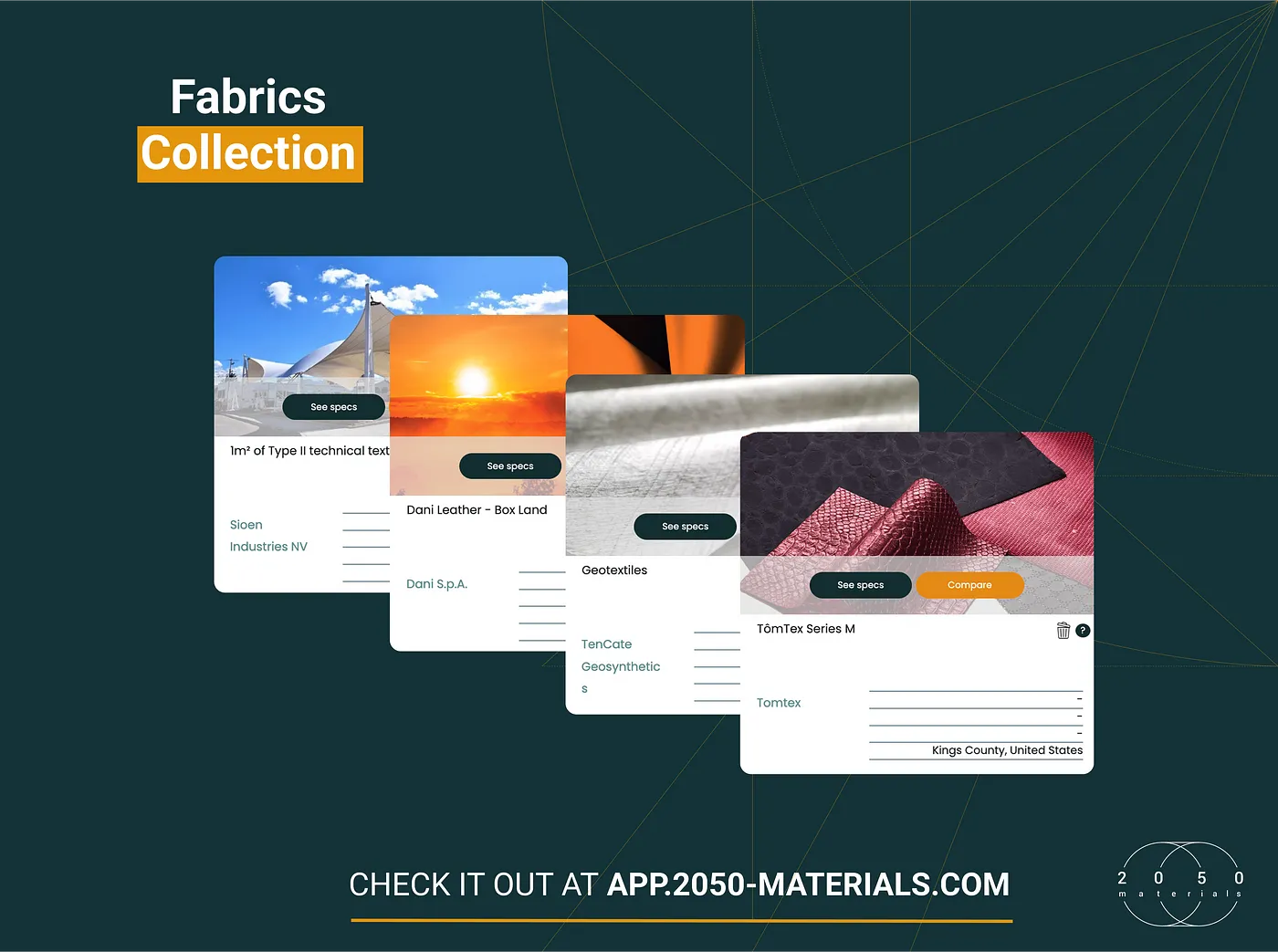
Introduction
Sustainability has become a key focus in the architecture, engineering and construction industry, as more companies shift towards reducing their environmental impact. In particular, the development of fabrics with sustainable properties is reshaping how we think about material use. From reducing carbon emissions to enhancing recyclability, the following fabrics represent a commitment to sustainability, paving the way for a greener future.
In this article and collection, we will explore 8 of the most innovative products in the fabrics category available on the 2050 Materials platform. These materials stand out not only for their innovative properties but also for their potential to significantly reduce environmental harm. Below, we detail their unique contributions to sustainability, explain their use cases, and show why they are more a better choice when compared to traditional materials.
1. Type II Technical Textile by Sioen Industries NV
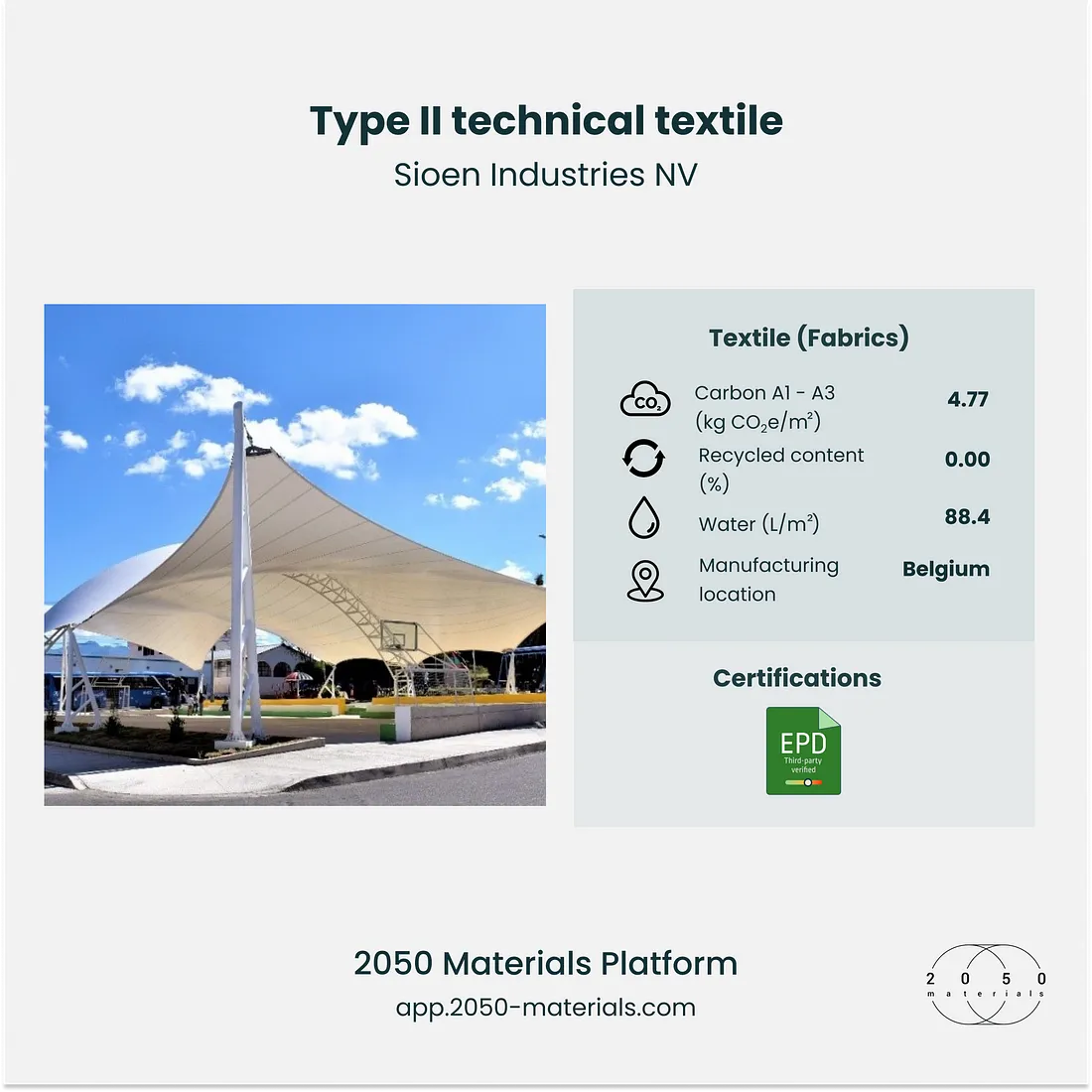
Product Overview:
Sioen’s Type II Technical Textile is a high-performance material used in tensile architecture, including facade coverings, sun-shading elements, and roof coverings.
Sustainability Performance:
This technical textile with an end-of-life usability score of 1.89kg/m2 and a recyclability score of 23.2%, outperforms traditional fabrics. It is made from a polyester (PET) fabric, coated with PVC and a finishing lacquer. The base fabric is a woven textile based on high tenacity multifilament polyester (PET) yarns. Each side of the fabric is coated with a well impregnated adhesion layer, a main layer consisting largely of PVC, UV stabilizers, flexing additives and other additives, and a thin acrylic and PVDF lacquer top coat which allows for a better cleaning ability, improved UV resistance and perfect weldability.
Its ability to be reused in different contexts makes it ideal for temporary or permanent architectural projects.
Advantages and Use Cases:
This material is primarily used in tensile structures, which require fewer materials and resources compared to conventional construction methods. Its application in shading and roof coverings further reduces energy consumption by promoting natural cooling and ventilation.
Explore Type II Technical Textile on 2050 Materials platform.
2. Vinyplan 6319 by Oy Scantarp Ab
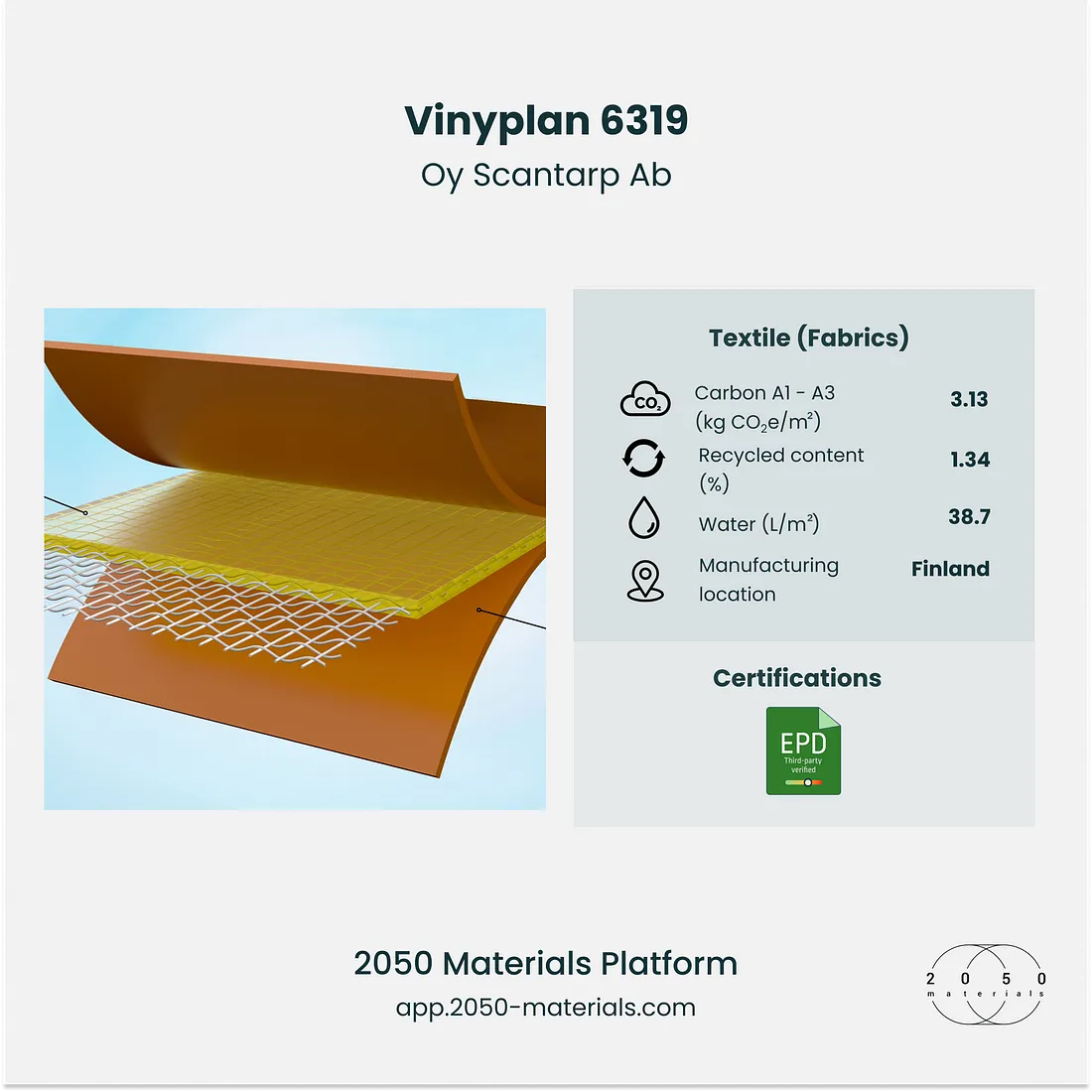
Product Overview:
Vinyplan 6319 is a versatile fabric used for various applications including protective covers, storage curtains, and partitions.
Sustainability Performance:
This fabric composition allows it to be used multiple times in various settings, reducing waste from single-use plastic alternatives.
The declared product is a polyethylene terephthalate — polyvinyl chloride (PET-PVC) based technical textile. The base fabric is composed of high tenacity, low shrinkage, multifilament polyester yarns. The product is coated symmetrically on both sides by 2 layers of coating, which include adhesion layer and main coating made out of PVC with several additives. Vinyplan 6319 is made with best performance REACH compliant chemicals. Due to the calendering processing technique, Vinyplan 6319 is fully airtight.
Advantages and Use Cases:
This material is predominantly applied in industrial and commercial contexts, where durability and cost-effectiveness are critical. Its versatility makes it suitable for projects that require flexibility and repeated use.
3. Geotextilien by TenCate Geosynthetics
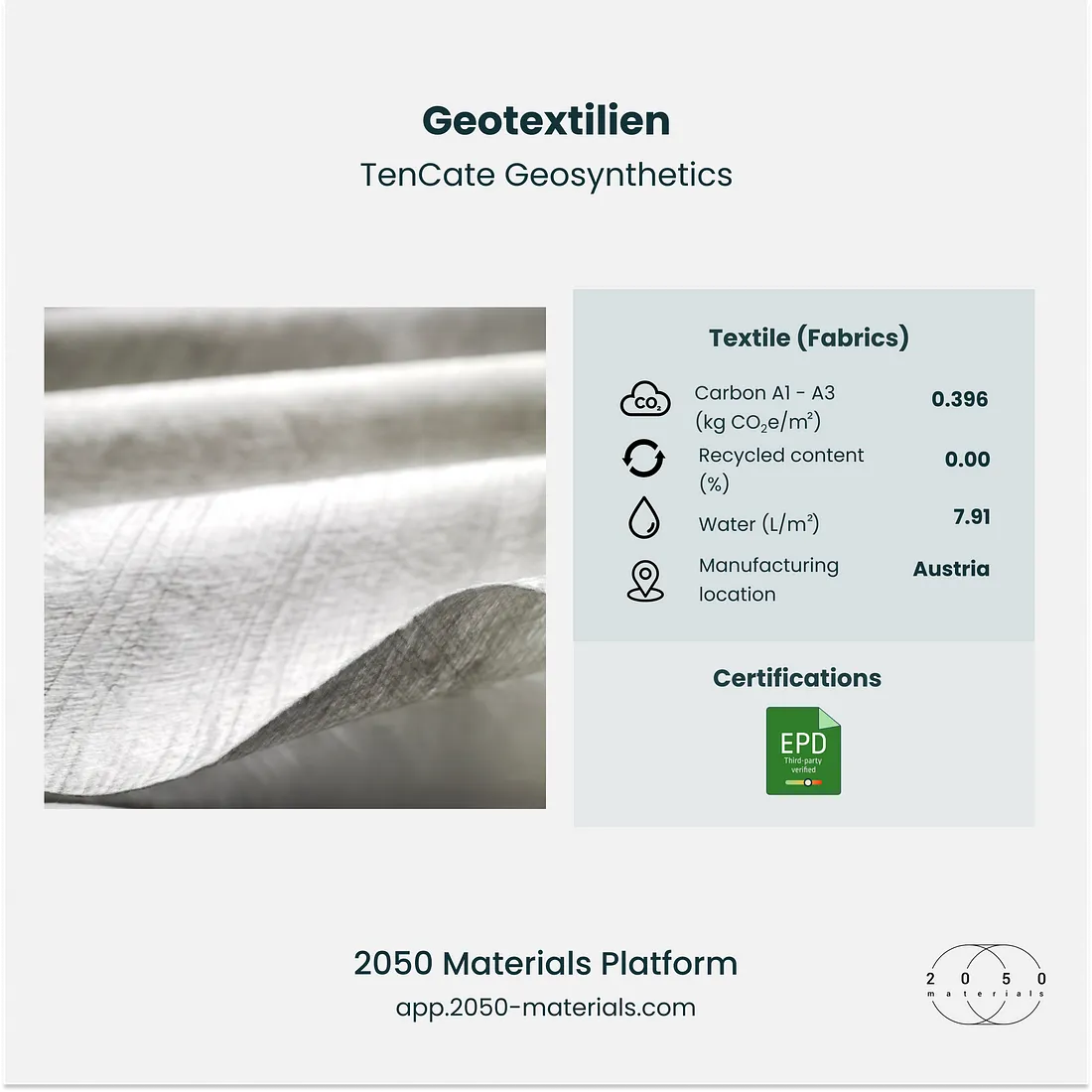
Product Overview:
Geotextilien is a mechanically consolidated Polypropylene with continuous fiber spunbond. The molding compound that comes with
is provided with special stabilizers and is widely used in geotechnical and civil engineering for functions such as separation, filtering, drainage, and protection. It ensures the long-term performance of soil-based structures.
Sustainability Performance:
The use of Geotextile in construction helps reduce the need for raw soil and filling materials, preventing soil erosion and contamination. Its environmental contribution lies in its role in protecting and extending the lifespan of structures.
Advantages and Use Cases:
Geotextilien is invaluable for large infrastructure projects, preventing the passage of contaminants through soil layers. It is most commonly used in drainage systems and landfills where its filtering capabilities help manage the safe disposal of waste.
4. Dani Leather — Box Land by Dani S.p.A.
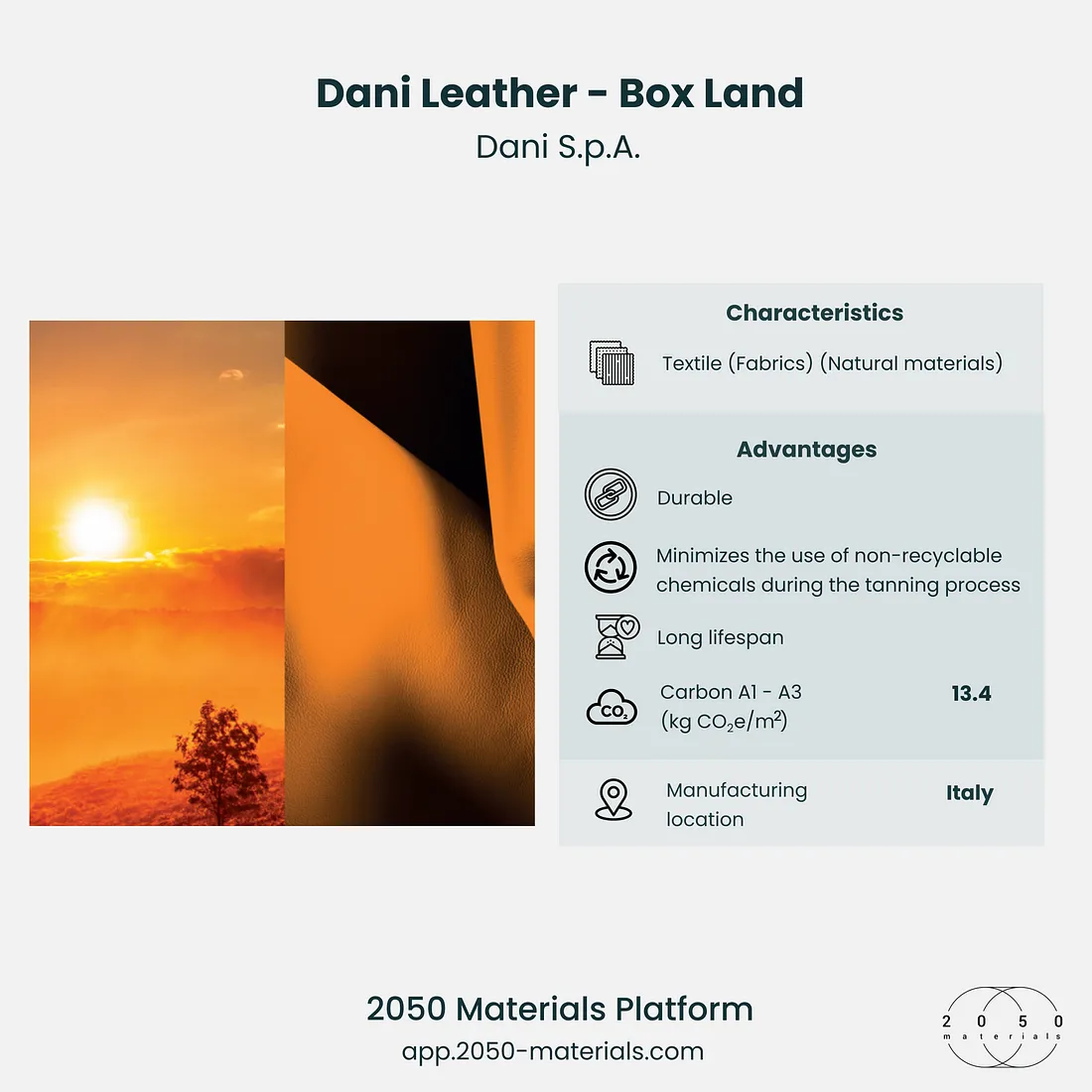
Product Overview:
Dani Leather — Box Land is a high-end leather product made from finished cowhide.
Sustainability Performance:
This leather is produced under stringent environmental guidelines, with attention paid to minimizing the use of non-recyclable chemicals during the tanning process.
The company invests in certifications as a communication tool of their daily commitment to improve the safety at workplace, the quality of their products, the reliability of their processes and the environmental impact of their processes. They show the implementation of advanced organisational models and the desire to improve their effectiveness and efficiency.
You can check their certifications here.
Advantages and Use Cases:
Dani Leather — Box Land is a premium leather option ideal for the luxury goods market. This fabric is used to put into practice bold ideas of stylists and designers, enhancing interiors and adding comfort and visual appeal to the most exclusive interiors. Its durability ensures a long lifespan, reducing the need for frequent replacements.
5. Acoustic Textiles FIBER 1 — Color Antimicrobial by Snowsound USA
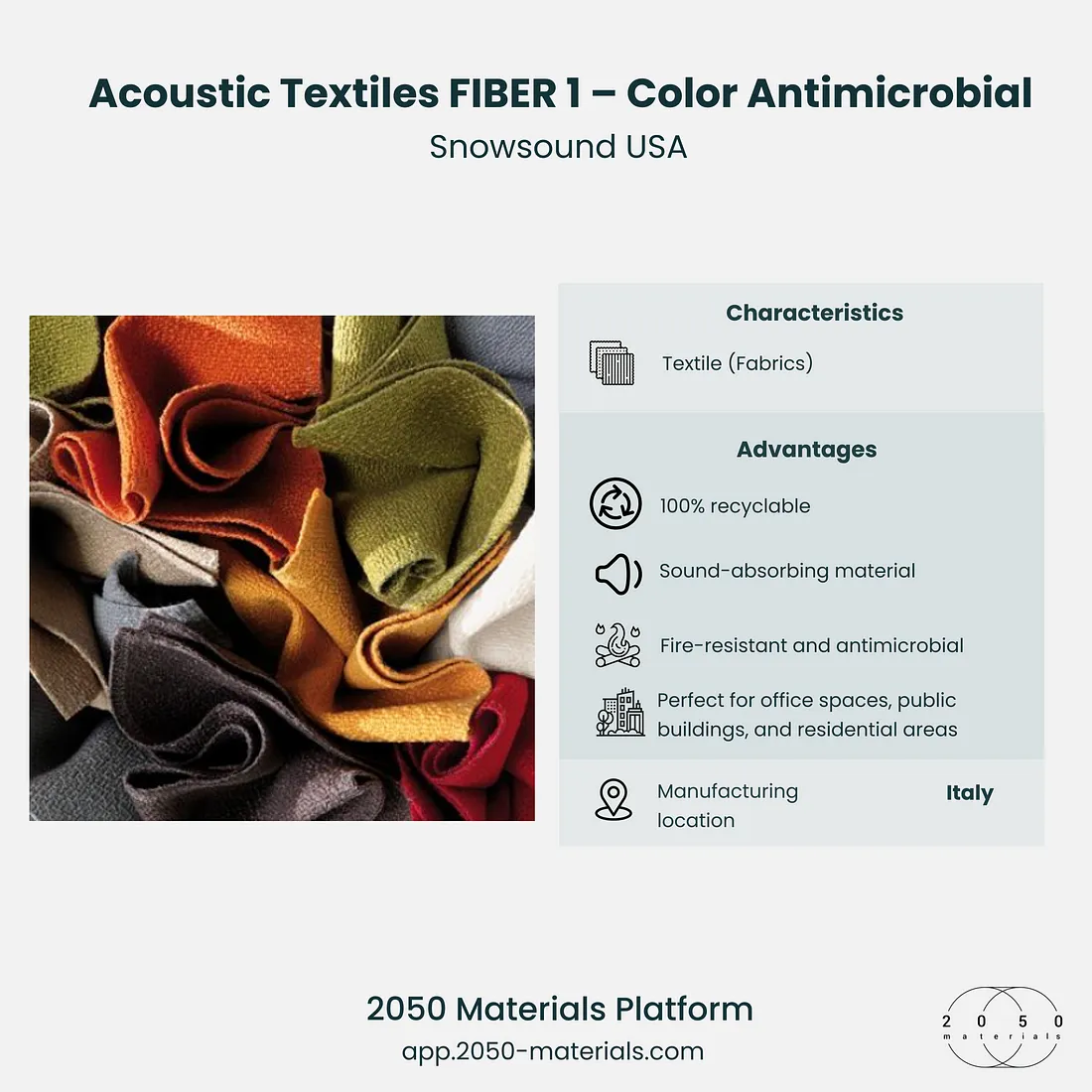
Product Overview:
Snowsound’s Acoustic Textiles FIBER 1 is a revolutionary sound-absorbing material with antimicrobial properties, making it a leading choice for acoustic solutions in interior design.
Sustainability Performance:
This textile is 100% recyclable and free from toxic chemicals. Its patented technology provides acoustic benefits while being permanently fire-resistant and antimicrobial, reducing the need for chemical treatments over time.
Advantages and Use Cases:
Primarily used in office spaces, public buildings, and residential areas where sound management is critical, Acoustic Textiles FIBER 1 provides a sustainable alternative to traditional soundproofing materials. Its antimicrobial properties also promote healthier indoor environments.
Explore Snowsound’s Acoustic Textiles FIBER 1 on 2050 Materials platform.
6. PIÑATEX® ORIGINAL CHARCOAL by Ananas Anam
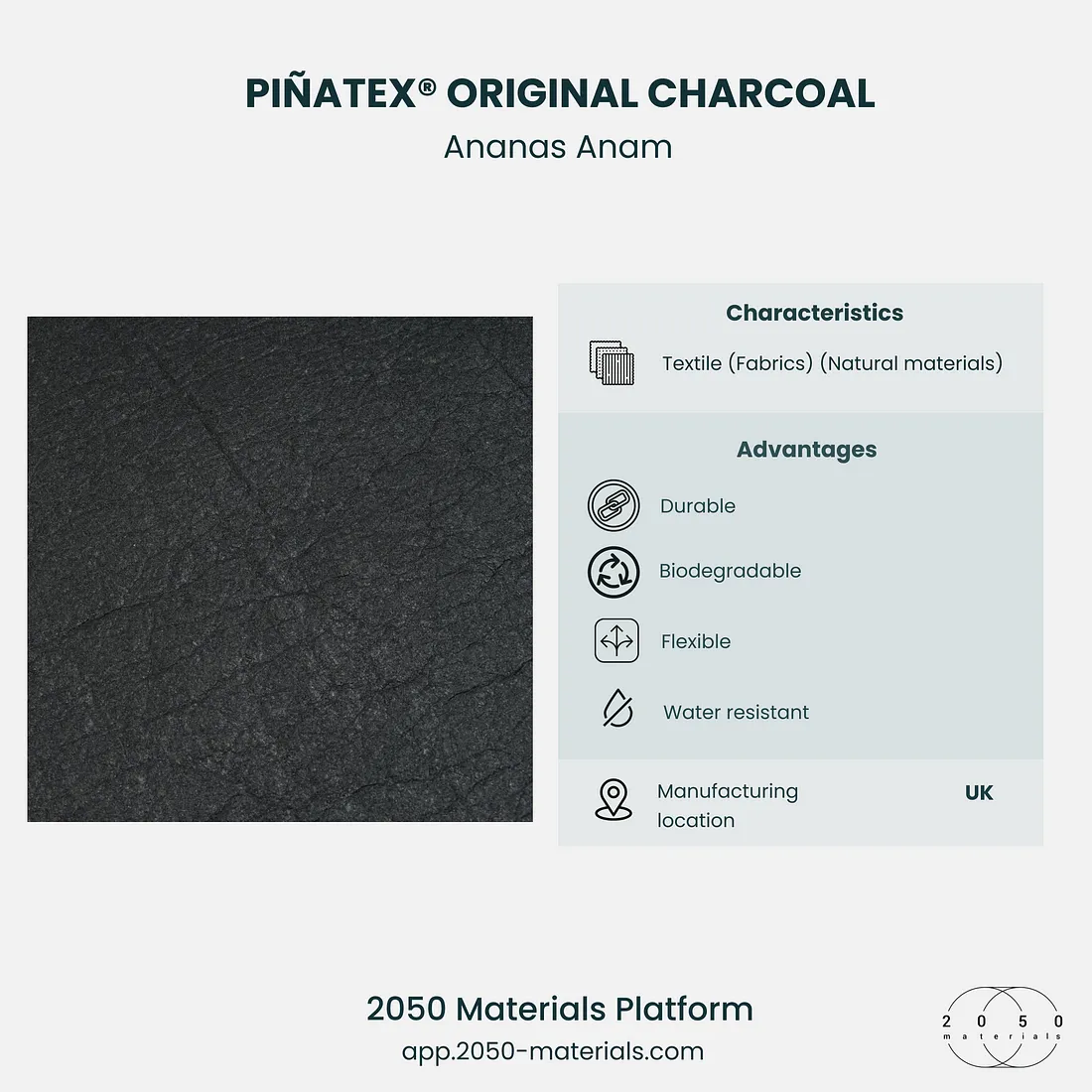
Product Overview:
PIÑATEX® is a vegan leather alternative made from pineapple leaf fibers, which are waste products from the pineapple industry.
Sustainability Performance:
This product excels in its use of agricultural waste, eliminating the need for additional cultivation and reducing waste. The manufacturing process minimizes non-recyclable chemicals, making it a strong alternative to animal leather and synthetic counterparts.
Advantages and Use Cases:
PIÑATEX® is used in fashion and furniture design, offering a biodegradable and durable option for interiors. Its flexibility and water-resistant properties make it highly desirable in sustainable markets.
7. i-felt by i-did
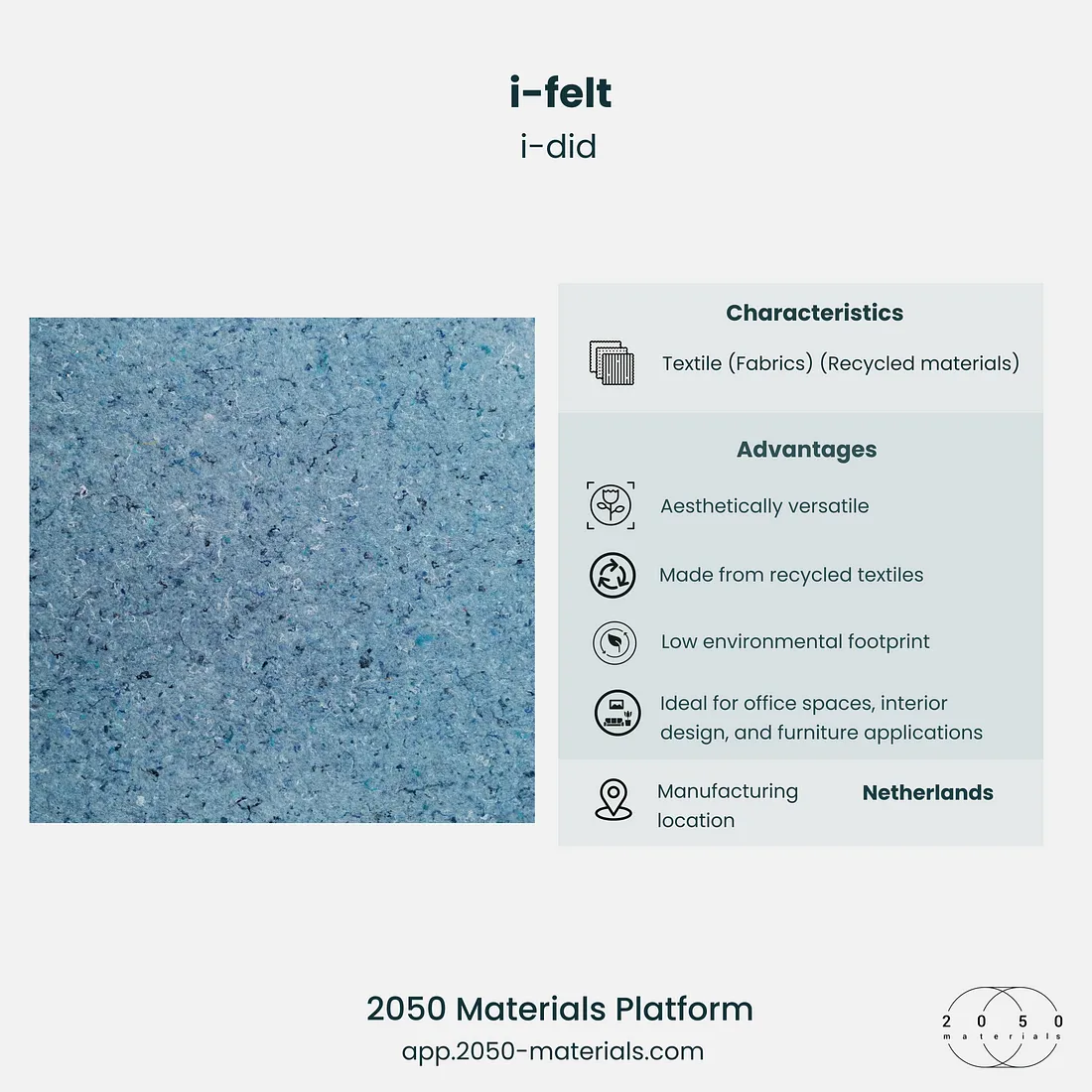
Product Overview:
i-felt is a felt material made from recycled textiles, including worn-out clothing and textile surpluses.
Sustainability Performance:
The product is manufactured using discarded textiles, drastically reducing waste and preventing clothing from ending up in landfills. As a result, i-felt has an exceptionally low environmental footprint. Its circular design supports sustainability by closing the loop on textile production.
Advantages and Use Cases:
i-felt is ideal for office spaces, interior design, and furniture applications where recycled materials can be creatively integrated. Its use of recycled textiles makes it both sustainable and aesthetically versatile.
8. TômTex Series M by Tomtex
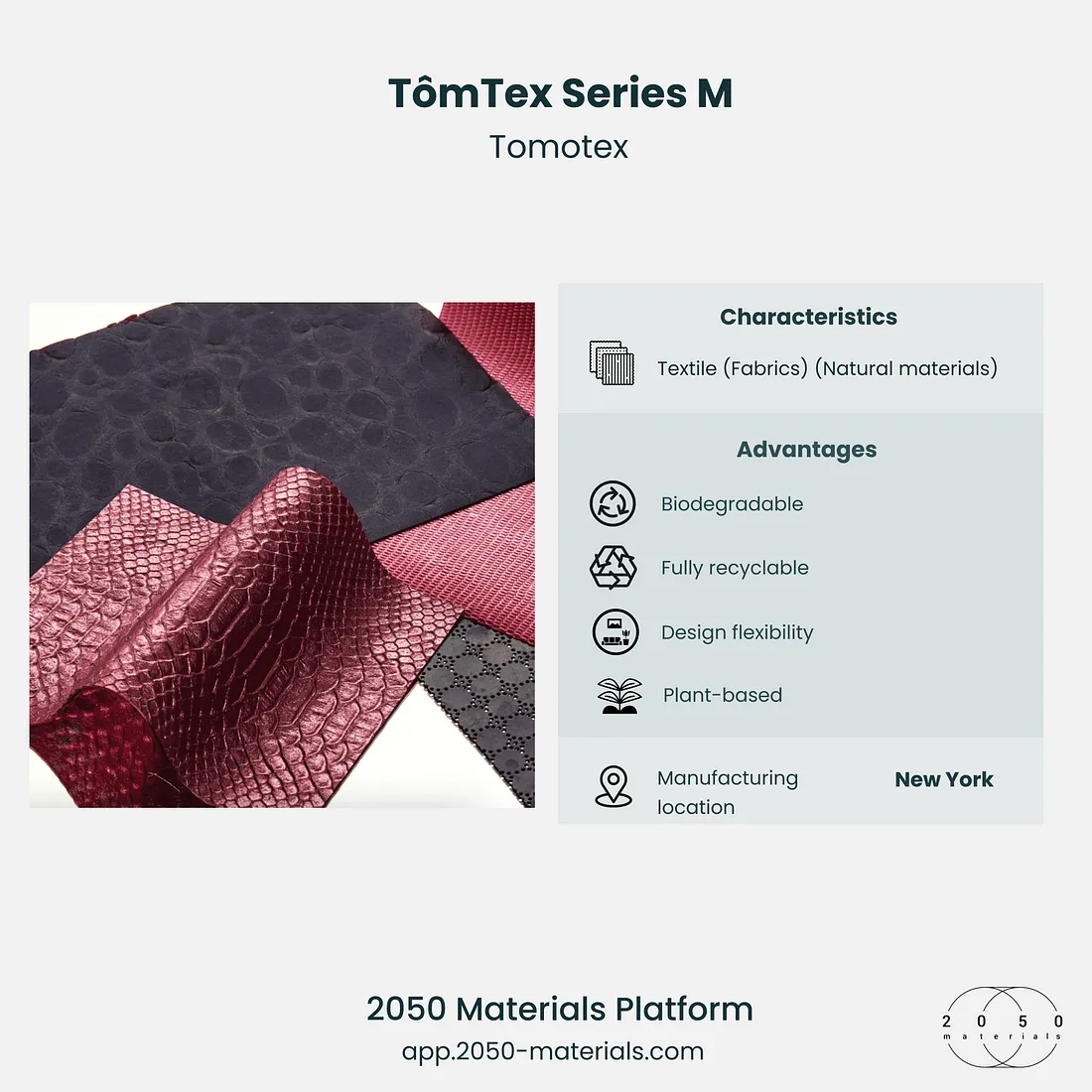
Product Overview:
TômTex Series M is a plant-based, biodegradable material made from seafood shell waste and coffee grounds, offering a suitable leather alternative.
Sustainability Performance:
TômTex’s material is 100% plastic-free and petrochemical-free, positioning it as a leading option in the move away from petroleum-based fabrics. The material is also fully recyclable, enhancing its circularity and reducing landfill waste.
Advantages and Use Cases:
This fabric is ideal for fashion designers and furniture makers seeking sustainable alternatives. It provides the flexibility to customize designs while offering a luxurious, leather-like texture without the environmental cost associated with traditional leather.
Conclusion
As sustainability becomes increasingly prioritized across industries, the fabrics highlighted in this collection are playing a critical role in promoting products with sustainable properties in design and construction. Whether through reducing waste, enhancing recyclability, or minimizing carbon footprints, each product offers unique advantages that are essential for creating a more sustainable future.
These materials serve as prime examples of how innovation can lead to better environmental outcomes without sacrificing performance or aesthetics. By exploring these options, designers and builders can make more informed decisions that align with the global push for sustainability.
Discover more products on 2050 Materials by browsing our platform.
Related articles

Climate-Resilient Materials for the Built Environment: A Data-Centred Prime
As climate volatility intensifies, resilience metrics are fast becoming as critical as carbon data in material selection. This article outlines why adaptation is now a design imperative, how materials can be evaluated through a systems lens, and what KPIs project teams should demand. From self-healing concrete to fire-rated façades, we present a structured taxonomy of resilient materials, explain how to embed this intelligence into digital design workflows, and propose next steps for specification, benchmarking, and procurement.
Read more
The Most Interesting Low Carbon Products in Office Design
In this article and collection, we highlight 11 outstanding products that contribute to a lower carbon footprint in office design.
Read more
Top Low Carbon Building Boards: Performance, Benefits, and Use Cases
The building boards highlighted in this article and collection showcase low-carbon innovation in modern construction.
Read more